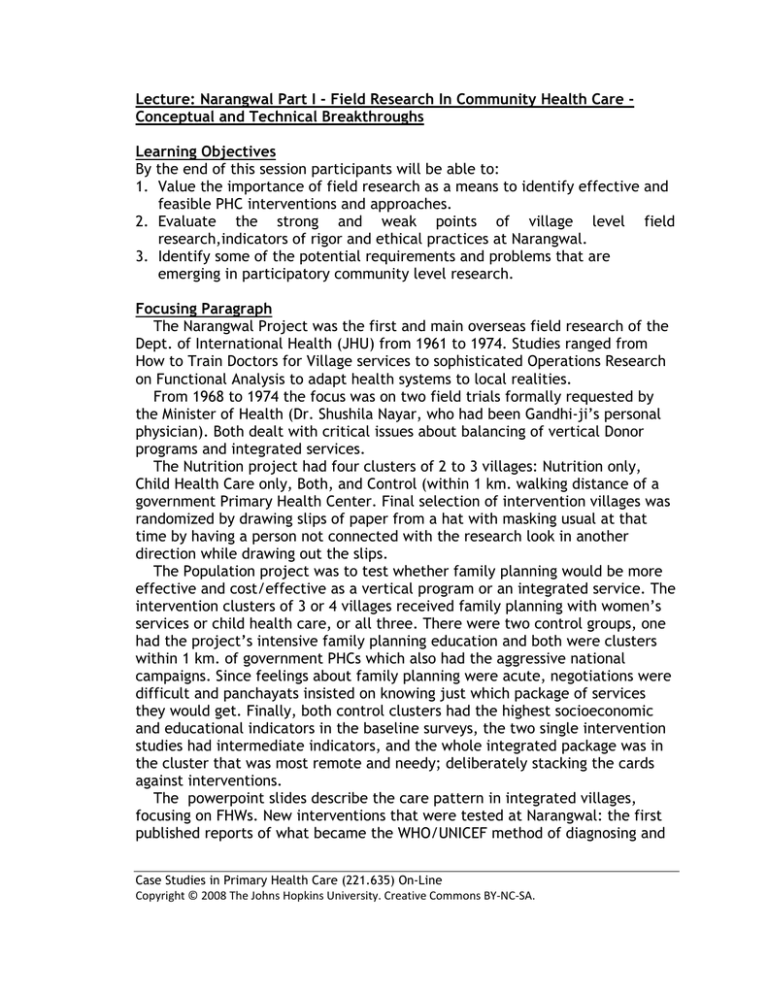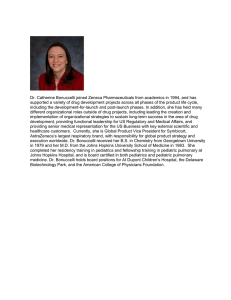Lecture: Narangwal Part I - Field Research In Community Health... Conceptual and Technical Breakthroughs
advertisement

Lecture: Narangwal Part I - Field Research In Community Health Care Conceptual and Technical Breakthroughs Learning Objectives By the end of this session participants will be able to: 1. Value the importance of field research as a means to identify effective and feasible PHC interventions and approaches. 2. Evaluate the strong and weak points of village level field research,indicators of rigor and ethical practices at Narangwal. 3. Identify some of the potential requirements and problems that are emerging in participatory community level research. Focusing Paragraph The Narangwal Project was the first and main overseas field research of the Dept. of International Health (JHU) from 1961 to 1974. Studies ranged from How to Train Doctors for Village services to sophisticated Operations Research on Functional Analysis to adapt health systems to local realities. From 1968 to 1974 the focus was on two field trials formally requested by the Minister of Health (Dr. Shushila Nayar, who had been Gandhi-ji’s personal physician). Both dealt with critical issues about balancing of vertical Donor programs and integrated services. The Nutrition project had four clusters of 2 to 3 villages: Nutrition only, Child Health Care only, Both, and Control (within 1 km. walking distance of a government Primary Health Center. Final selection of intervention villages was randomized by drawing slips of paper from a hat with masking usual at that time by having a person not connected with the research look in another direction while drawing out the slips. The Population project was to test whether family planning would be more effective and cost/effective as a vertical program or an integrated service. The intervention clusters of 3 or 4 villages received family planning with women’s services or child health care, or all three. There were two control groups, one had the project’s intensive family planning education and both were clusters within 1 km. of government PHCs which also had the aggressive national campaigns. Since feelings about family planning were acute, negotiations were difficult and panchayats insisted on knowing just which package of services they would get. Finally, both control clusters had the highest socioeconomic and educational indicators in the baseline surveys, the two single intervention studies had intermediate indicators, and the whole integrated package was in the cluster that was most remote and needy; deliberately stacking the cards against interventions. The powerpoint slides describe the care pattern in integrated villages, focusing on FHWs. New interventions that were tested at Narangwal: the first published reports of what became the WHO/UNICEF method of diagnosing and Case Studies in Primary Health Care (221.635) On-Line Copyright © 2008 The Johns Hopkins University. Creative Commons BY-­‐NC-­‐SA. treating pneumonia in babies, the Verbal Autopsy method for cause of death, and also the second publication of effective oral rehydration therapy. Reflective Question What were some of the important lessons learned at Narangwal that you feel would be helpful in planning community-based field research projects that you may be involved in sometime in the future? How would such projects deal with the issues raised above? Lecture: Narangwal Part II - Dilemmas in CBPHC Field Research Learning Objectives 1. To make judgments about the long term impact of the Narangwal Field Trials which were among the earliest field trials testing modern interventions and perhaps the first to compare vertical and integrated packages for implementation in real life villages. 2. To talk in depth about the reality that all vertical approaches, even surveillance after eradication, have to eventually be integrated with health systems. To be considered are issues such as: Entry Points when an intervention facilitates other services, cost/effectiveness when use of the same infrastructure eliminates duplication, especially convenience for families and community empowerment. 3. To discuss the fact that almost forty years after these field trials were started, two reviews raised questions miss-interpreting the methodology and ethics: The Cochrane Reviews rejected the project for lack of rigor because of inadequate randomization, especially of controls, and the Indian Journal of Medical Ethics had detailed objections to the fact that there were any controls at all. Focusing Paragraph In field research at the community level investigators face a number of trade-offs. There is frequently the need to balance scientific rigor with potential compromises needed to attain community consent and participation. Usually, the community will not see the research topic as one of their priorities. This may give rise to the need to build in activities not directly tied to the original research questions that do address community perceived needs. There are also ethical considerations when utilizing control or comparison communities. Successful interventions may need to be extended to control communities at the end of the study in order to make such controlled studies ethical as part of community participation. In fact that had been promised but the project was terminated prematurely as part of U.S. tilt to Pakistan during the Bangladesh War. Community level research usually involves many potentially unforeseen situations arising from working within the complex social-cultural factors existing in every community, many of which are not well understood and differ Case Studies in Primary Health Care (221.635) On-Line Copyright © 2008 The Johns Hopkins University. Creative Commons BY-­‐NC-­‐SA. significantly from place to place. Thus community level research, if it is to be successful, may have to dynamically and continuously adapt its design and testing of interventions during the life of the research study depending on community concerns. This can be a positive learning experience even at the expense of not having an unchanging intervention that is tested. Innovative “process” measures of any changes (both quantitative and qualitative) in the research design and interventions, as well as their timing, may be required and carefully analyzed in order to provide evidence of what actually made a difference in the outcome measures. It is increasingly evident that rigorous insistence on Objectivity interpreted as excluding people being benefited from any involvement because of presumed Bias is in direct conflict with participatory principles and purposes. Perhaps there is need for other ways of eliminating Bias or measuring it as a part of ensuring good quality through community empowerment. At present the purity of IRB protection of research ethics depends of expert and professional judgment. Some of the emerging questions require consideration of the possibility that maybe it is time to get community representation on IRBs, with all of the complexities that will introduce. Reflective Question What would be your approach to involve the community if you ever carry out a field research project? How would you balance goals to develop effective PHC interventions with using participatory research methods to get benefits of people’s participation? Are the two goals in automatic conflict or can they be synergistic? Reading Required Reading • • Chapter 10 - Narangwal: The Role of Conceptual and Cultural Breakthroughs, in Just and Lasting Change: When Communities Own Their Futures, D. Taylor-Ide and C.E. Taylor, Editors. 2002, Johns Hopkins University Press: Baltimore and London. P.200-207 Taylor, CE, Parker, RL. Integrating PHC Services: Evidence from Narangwal, Health Policy and Planning 1987, 2(2):150-161 Optional Reading • • Briggs CJ, Garner P (2006). Strategies for integrating primary health services in middle- and low-income countries at the point of delivery. Cochrane Database of Systematic Reviews 2006, Issue 2. Taylor (2007). Response to Cochrane Review Case Studies in Primary Health Care (221.635) On-Line Copyright © 2008 The Johns Hopkins University. Creative Commons BY-­‐NC-­‐SA. • • IJME First Packet 2007 Taylor (2008). Response to IJME Case Studies in Primary Health Care (221.635) On-Line Copyright © 2008 The Johns Hopkins University. Creative Commons BY-­‐NC-­‐SA.




